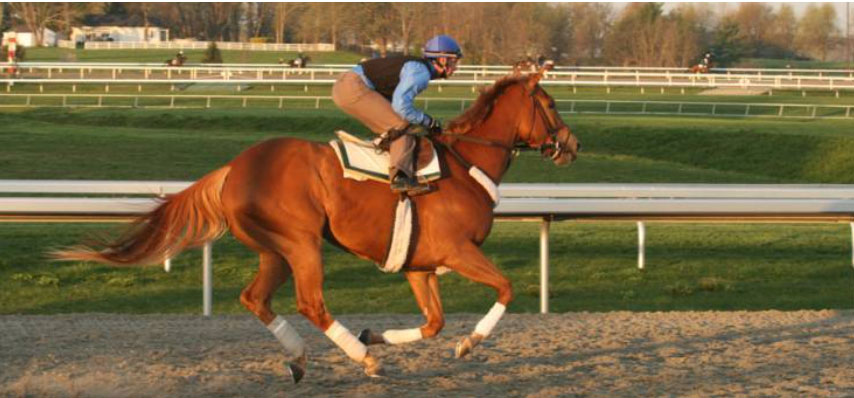
by Kentucky Equine Research Staff
In addition to the host of intangibles involved in training horses, adding science to the mix may help improve a racehorse’s chance of success. According to a group of European researchers, measuring stride length and frequency—how far horses stretch their limbs and how fast they move their legs—during training could assist in race length selection.*
To explore whether stride characteristics could help classify racehorses as sprinters or stayers, a wearable smart device was commissioned. The device recorded peak stride length and frequency as well as speed in a large cohort of racehorses during training sessions.
“In those race-speed training sessions, locomotory differences were detected, with sprinters having shorter strides of higher frequency than stayers,” explained Catherine Whitehouse, M.S., of Kentucky Equine Research.
In addition, peak stride length was found to be moderately heritable after reviewing three generations of pedigrees from included horses.
“A better understanding of individual stride characteristics could help racehorse professionals select suitable race distances, while also taking into account their own experience at placing racehorses in suitable meetings alongside other historical aspects of how racehorse conformation and pedigree information can influence such decisions,” according to the research team.
“In other words, not only will identifying whether a horse is more suited to shorter or longer races improve their chances of winning but also allow trainers to develop more specific training sessions,” Whitehouse noted. “Targeted training that considers speed, stride frequency and length, and biomarkers of fatigue may, in turn, promote longer careers and improve welfare on the track.”
Regardless of a Thoroughbred’s individual stride characteristics, all racehorses must withstand joint concussion during training and racing.
“Offer Synovate HA to keep those joints lubricated for friction-free movement and to maintain a healthy balance between cartilage growth and breakdown,” advised Whitehouse.
Synovate HA is a high molecular weight hyaluronic acid supplement that provides 100 mg per serving for targeted support to high-motion joints.
“A Kentucky Equine Research study showed horses supplemented with Synovate HA maintained their stride length during a high-speed treadmill training program compared to the control group,” she added.
*Schrurs, C., S. Blott, G. Dubois, E. Van Erck-Westergren, and D.S. Gardner. 2022. Locomotory profiles in Thoroughbreds: peak stride length and frequency in training and association with race outcomes. Animals (Basel) 12(23):3269.
Reprinted courtesy of Kentucky Equine Research. Kentucky Equine Research is an international equine nutrition, research, and consultation company serving horse owners and the feed industry. Our goals are to advance the industry's knowledge of equine nutrition and exercise physiology, apply that knowledge to produce healthier, more athletic horses, and support the nutritional care of all horses throughout their lives. Learn more at Kentucky Equine Research.
There a more informative articles in our section on Health & Education. While you're here be sure to visit our Curated Amazon Store.

































